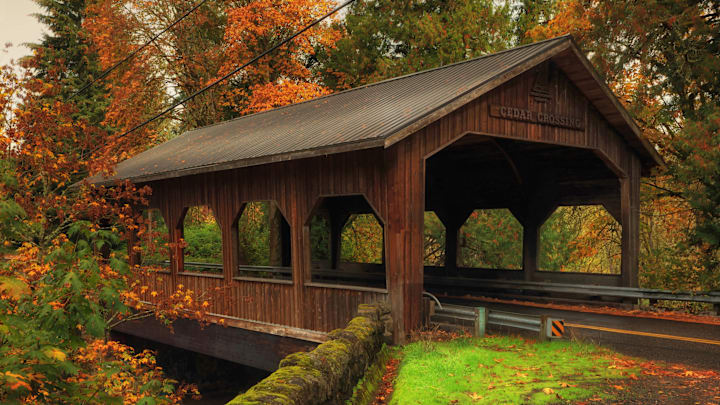When you drive a car over a covered bridge, it’s easy to feel like you should be in a horse-drawn carriage instead. They call to mind quaint New England towns, vibrant fall leaves, and a simpler era. But these charming bridges generally aren’t built anymore; whereas there used to be over 14,000 of them in the United States, only about 500 to 600 remain. So what happened to these old-timey structures, and why are all the newer bridges open on top?
Why Were Bridges Covered in the First Place?

Covered bridges weren’t designed just for looks. The reason the covers were built in the first place was to protect the bridge—which was constructed entirely out of wood—from the elements. Wind and rain could erode and damage it, eventually causing the wood to rot away and become unstable. The covers help mitigate that risk and keep the bridge’s supports dry, significantly increasing its lifespan.
Such a design made its first U.S. appearance in Philadelphia, when the Permanent Bridge was erected to cross the Schuylkill River in 1805. It lasted 70 years—including a later expansion to allow railway traffic through—before ultimately being destroyed in a fire. Unfortunately, this is a common story for covered bridges throughout history. Despite their increased protection, they are still very susceptible to flooding and fires in particular; many of these historic structures have had to be completely rebuilt after burning down.
You May Also Like:
- 10 Places That No Longer Exist
- Why Don't We Have World’s Fairs Anymore?
- 12 Stops on the Ultimate Fall Foliage Road Trip
Add Mental Floss as a preferred news source!
The Shift to Modern Bridges

Most bridges built today are made of steel and/or concrete, and in fact, it was the growth of the steel industry that marked the major shift away from old-fashioned covered ones. The vast majority of covered bridges in the U.S. were built from the 1820s through the 1870s, pulling from regional abundances of timber; wooden bridges were, by far, the most cost-effective option. But as industrialization advanced in the mid-19th century, the mass production of iron and steel became possible.
These metals were stronger than wood, resistant to rot and fire, and could suddenly be accessed at historically low prices. They were no-brainers for new construction, and by the early 20th-century, covered bridges were essentially a thing of the past. Many covered bridges across the country were even torn down in favor of steel and/or iron replacements, setting up the beginnings of contemporary American infrastructure.
Today, many covered bridges are considered historical sites in the United States. Organizations like the National Society for the Protection of Covered Bridges and the federal National Historic Covered Bridge Preservation program work to maintain them, inform the public about their history, and research new methods of preserving them for future generations. To see if there are any covered bridges near you, you can check out this map and hopefully enjoy a little piece of history.
